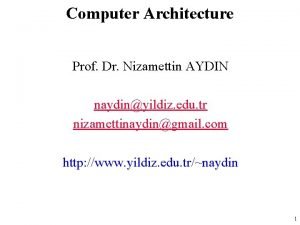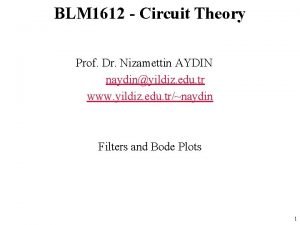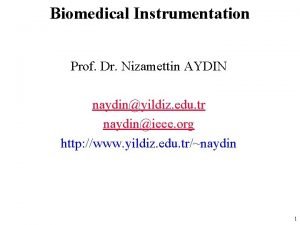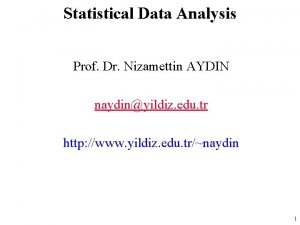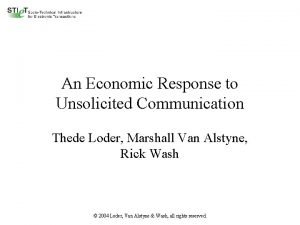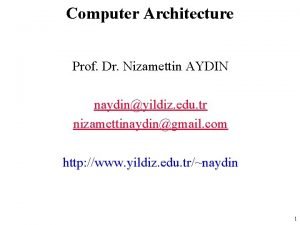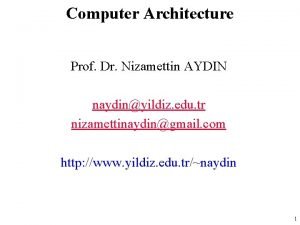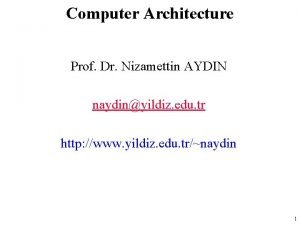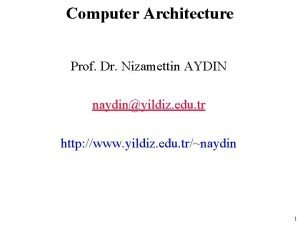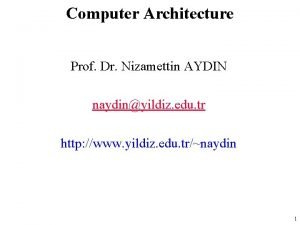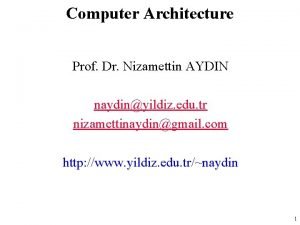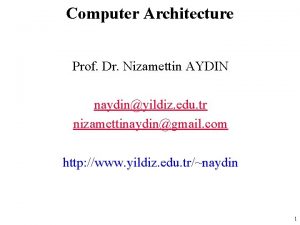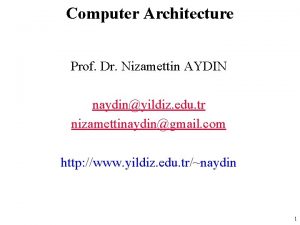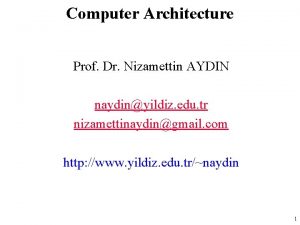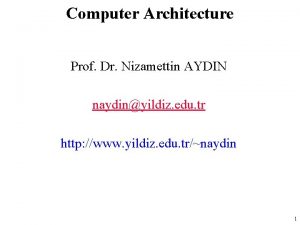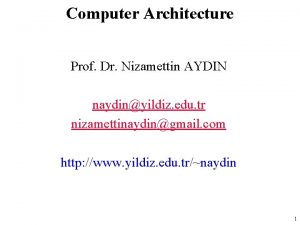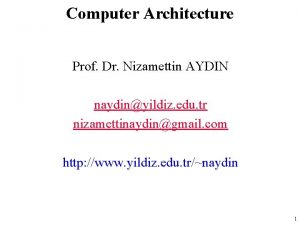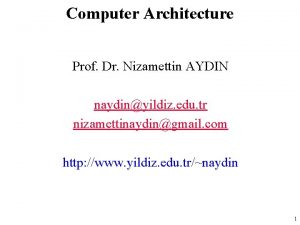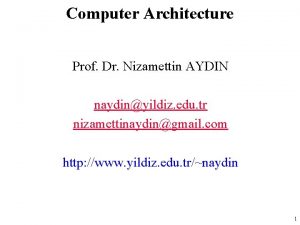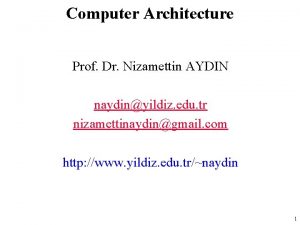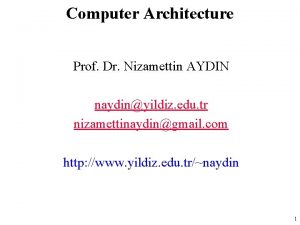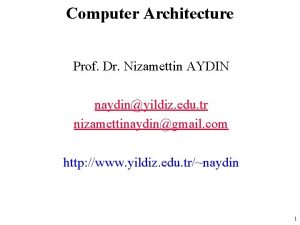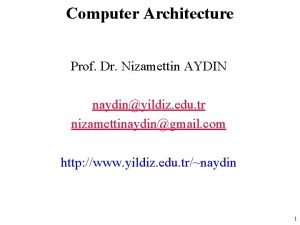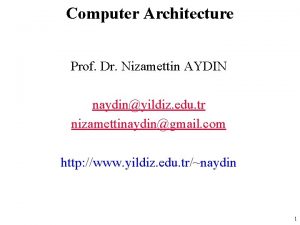Computer Architecture Prof Dr Nizamettin AYDIN naydinyildiz edu























- Slides: 23

Computer Architecture Prof. Dr. Nizamettin AYDIN naydin@yildiz. edu. tr http: //www. yildiz. edu. tr/~naydin 1

Addressing Modes and Formats 2

Addressing Modes • • Immediate Direct Indirect Register Indirect Displacement (Indexed) Stack 3

Immediate Addressing • Operand is part of instruction • Operand = address field • e. g. ADD 5 – Add 5 to contents of accumulator – Here 5 is operand • No memory reference to fetch data • Fast • Limited range Instruction Opcode Operand 4

Direct Addressing • Address field contains address of operand • Effective address (EA) = address field (A) • e. g. ADD A – Add contents of cell A to accumulator – Look in memory at address A for operand • Single memory reference to access data • No additional calculations to work out effective address • Limited address space 5

Direct Addressing Diagram Instruction Opcode Address A Memory Operand 6

Indirect Addressing (1) • Memory cell pointed to by address field contains the address of (pointer to) the operand • Large address space • 2 n where n = word length • May be nested, multilevel, cascaded • Multiple memory accesses to find operand • Hence slower 7

Indirect Addressing Diagram Instruction Opcode Address A Memory Pointer to operand Operand 8

Register Addressing (1) • • Operand is held in register named in address field EA = R Limited number of registers Very small address field needed – Shorter instructions – Faster instruction fetch • • No memory access Very fast execution Very limited address space Multiple registers helps performance – Requires good assembly programming or compiler writing 9

Register Addressing Diagram Instruction Opcode Register Address R Registers Operand 10

Register Indirect Addressing • Operand is held in memory cell pointed to by contents of register R named in address field • EA = (R) • Large address space (2 n) • One fewer memory access than indirect addressing 11

Register Indirect Addressing Diagram Instruction Opcode Register Address R Memory Registers Pointer to Operand 12

Displacement Addressing • EA = A + (R) • Address field hold two values – A = base value – R = register that holds displacement – or vice versa 13

Displacement Addressing Diagram Instruction Opcode Register R Address A Memory Registers Pointer to Operand + Operand 14

Relative Addressing • • A version of displacement addressing R = Program counter (PC) EA = A + (PC) i. e. get operand from A cells from current location pointed to by PC 15

Base-Register Addressing • • A holds displacement R holds pointer to base address R may be explicit or implicit e. g. segment registers in 80 x 86 16

Indexed Addressing • • A = base R = displacement EA = A + R Good for accessing arrays – EA = A + R – R++ 17

Combinations • Postindex • EA = (A) + (R) • Preindex • EA = (A+(R)) 18

Stack Addressing • Operand is (implicitly) on top of stack • e. g. – ADD Pop two items from stack and add 19

Summary of basic addressing modes 20

Instruction Formats • • Layout of bits in an instruction Includes opcode Includes (implicit or explicit) operand(s) Usually more than one instruction format in an instruction set 21

Instruction Length • Affected by and affects: – Memory size – Memory organization – Bus structure – CPU complexity – CPU speed • Trade off between powerful instruction repertoire and saving space 22

Allocation of Bits • • • Number of addressing modes Number of operands Register versus memory Number of register sets Address range Address granularity 23
 Prof. dr. nizamettin aydin
Prof. dr. nizamettin aydin Nizamettin aydin
Nizamettin aydin Prof. dr. nizamettin aydin
Prof. dr. nizamettin aydin Prof. dr. nizamettin aydin
Prof. dr. nizamettin aydin Nizamettin aydin
Nizamettin aydin Package diagram
Package diagram Giga tera peta
Giga tera peta Sinan aydın mali müşavir
Sinan aydın mali müşavir Aydın kendirci
Aydın kendirci Unsent message to aydin
Unsent message to aydin Sevil aydın
Sevil aydın Aydın bir türk kadınıyım
Aydın bir türk kadınıyım Bushra aydin
Bushra aydin Organization
Organization Aydin marine
Aydin marine Aydın başar
Aydın başar Nazmi aydın
Nazmi aydın Aydin bal
Aydin bal Aydın kekemelik merkezi
Aydın kekemelik merkezi Buses in computer architecture
Buses in computer architecture Difference between computer organisation and architecture
Difference between computer organisation and architecture Flowchart for memory reference instructions
Flowchart for memory reference instructions Edu.sharif.edu
Edu.sharif.edu Architecture business cycle
Architecture business cycle

